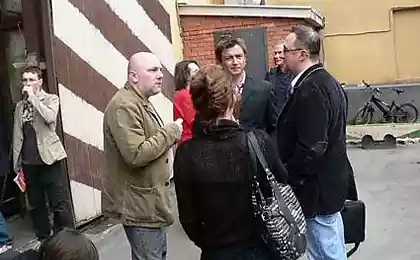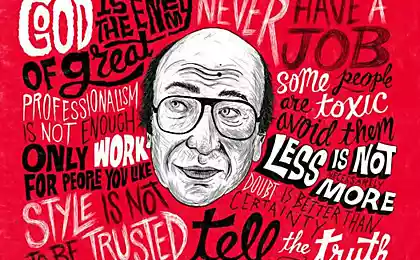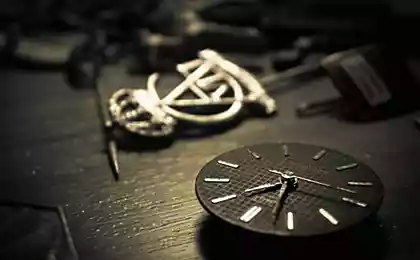698
Milton Glaser on the makeovers and the style of our time
Interview with the author of the logo I Love New York.Milton Glaser is one of the most famous designers of the United States, the artist that has created a huge number of masterpieces of graphic design, including the famous logo I ♥ NY. In addition to practice, 80-year-old Glaser is engaged and theory: lectures at universities, writes essays and theoretical arguments about the relationship of art and design and their influence on each other, about the profession of the designer and the complexities of the creative process.
Seventy two million six hundred sixty four thousand eight hundred two
— Surprisingly, you grew up in a Russian neighborhood in the Bronx with neighbors who spoke about Trotsky and Stalin, met with our vanguard still in art school. Russian culture has influenced you?
— I'm influenced by many things, but Russian avant-garde was of course one of the main sources of inspiration. Besides him I really liked the history of the art of the Renaissance. I studied in Italy with Giorgio Morandi and were very eclectic in their content. I think the best basis for work — history of art in General. None of the styles does not give a comprehensive view of the world — each one is limited and the designer can rely on any of them depending on the task that it solves.
— Yes, in one interview you said that there is no absolute style, as there is no absolute truth — and the style reflects above all the spirit of his time.
Just so. Style is not the set of specific preferences and individual images, it is a full invention of the culture of a certain epoch. Culture evolves as a whole, this involved a lot of people, and they all create a style. For people of my generation, the ideas of modernism and constructivism seemed to be the most correct, the most logical. These ideas have even become the code of conduct as if they were laid out the absolute truth. But in fact they just reflect the agreement of certain people at a certain time on a certain key set of questions. No one can know absolute truth.
— How would you describe the style of today?
— In the United States is dominated by a mixture of post-impressionism and postmodernism in half with street culture, which is created by the people that draw graffiti on the streets. This is the exact image of our time. Still alive, the old gods are trying to protect modernist and postmodernist views — but they are opposed by people trying to relieve them from the podium, to make a revolution, to destroy everything old. We can see the amazing period in design with references to the culture of modernism the United States, Russia and the Bauhaus — and rebellious young people trying to send it all to the scrap. This happens at the same time. I often think about that today, the set of references is very limited, and due to this around the world we can see the same work of designers around the world are remarkably similar to one another. I see this as a serious limitation. And survival all this must be destroyed. It is impossible to see the future, but I can say with certainty: what we do today obsolete.
— You once said that design is every ten years ... Remember the most notable developments in your career?
It is hard to say — these changes don't happen in a moment and we can not say that yesterday in the design of everything was here and now — that way. When we started Push Pin Studios with Reinhold Raffinan, the eye of the then existing gap between illustration and design. We wanted to work on that, and on the other, combine them into a single visual culture. Most designers then really could not draw and worked in the collage technique. And we wanted to use all of this: we worked with collage, but also painted pictures, studied typography... I have always been interested in working with a variety of techniques and areas instead of focus on one thing and to assert that only it is design.
Forty eight million six hundred sixty six thousand seventy one
www.miltonglaser.com/
— How you have changed during this time?
— Analyze yourself is not easy. In my career I tried to learn all the time something new. As soon as I have something started to happen, I moved on to something else. Over the years I've also been doing illustrations and more interested in abstract works, more complex, but more straightforward in its meaning, more understandable. I began to think more about the ideas than about the objects themselves. Many people understand the design correctly. It is not about how things look, it is about the relationship between words and pictures, narrative and aesthetics, colour and form. The visualization shows how everything is connected, and I tried to explore it more and more.
— What do you think about his early works?
— When I'm going through your archives, I often look at old work, and they seem to me terrible. I then understood everything and did wrong — but could I then do differently? I'm happy that you haven't abandoned design that I get better and better. I understand that drew a lot of terrible work, but each of us has to make mistakes in order to begin to better understand the business. Success in this sense is a bad tool: it does not promote growth of skill.
— You often cite the example of Picasso, who once reached in one success, immediately threw it and started to do something else. How can we achieve mastery? If so much to throw away, you can in all that you undertake to remain an Amateur.
Is a very good question. On the one hand, I could say — and who is generally important. On the other hand, the biggest danger in the career of a designer is that people will love your unique style, some of your techniques. And you have again and again to repeat what has success brought to you a long time ago. Instead do something new and to do something extraordinary in this new area, you prefer not to risk it, because your audience may judge you. You're getting hung up on what already know — and this is the biggest limitation that can happen in life. On the one hand, it is important to feel that you are doing something that you really interesting, but other than that, you're risking your well-being and success. It's a sad choice.
Thirteen million one hundred ninety eight thousand eight hundred fifty six
www.miltonglaser.com/
— At what point do you realize that you are ready to take risks and do something new?
— This is a very personal question and everyone will answer it differently. Should be a very special desire, understanding that you want to continue to develop your mind, talents and instincts. We live a long life, and we want to make new discoveries. But these discoveries do await us! As soon as you realize you've achieved everything you wanted, it is important not to stop — because otherwise you're not doing anything important for his family, country, and, perhaps, for himself.
I was always wondering how the designers understand that the work is done — it is possible to bring the logo to perfection eternity and forever to offer new options.
— This is very interesting, because my students often ask me about it: how do you understand that the job is finished? The only accurate answer I know this has nothing to do with time. Sometimes you need ten minutes to do all the work, and sometimes you don't have time to finish it nor over weeks, nor over months. There's no waste of algorithms to assess that you have achieved the best result possible, you will probably understand it intuitively. A practicing designer, used to live among the limitations: it limits the customer's order, own possible. We need to meet these requirements. Whether your audience this work? If feel the client that with the help of your work it will be able to achieve their goals — for example, to sell something or to convince people of something? Do you feel yourself that you have found a suitable solution may be the best possible? If you answer "Yes", then the job is done. It's hard for me to formulate this more precisely, but any experienced designer learns to understand and to feel.
— You have a lot of projects done in ten minutes?
— A lot — and more and more. I have quite unconsciously begin to line up the right connections in my head. And then now I rarely work alone, I don't even need to touch the computer. I have wonderful colleagues, and I often sit next to sue and said: "we Have a job, sue, and we only have 20 minutes to do it." And we do this because sometimes such restrictions allow us to find unexpected answers, such that we can be, and would not think of them in a more comfortable situation.
Forty six million two hundred twenty three thousand two hundred thirty eight
www.miltonglaser.com/
— You are tired of the consumer society? You can say you serve him all his life.
One of my main rules in the design is not to harm. The designer should bear the same responsibility to society as the doctor. Of course, no one wants to hurt anyone, but sometimes to understand what is the harm, it becomes very difficult. You need to be very attentive to the consequences. I would never work for a tobacco company or a company that produces beverages that cause diabetes — it is very obvious. Other tasks are forced to make difficult moral and ethical choices. My students I talk a lot about the social responsibility of design, I tell them that the design should benefit society. The design has a political voice, he interacts with a culture that is enlightened. If not always but a lot of people involved in socially responsible design.
— You spoke about the incredible importance of art — that is art that helps the culture to survive. What do you mean?
The reason why the art when it appeared, was social. People decided together to create something that would reflect the story of bear hunting. The reason why art exists now — is a common activity for people. Art is as corrupt as any other institution, but while it has an important non-goal: it brings together. Whoever we may be, but if you like Mozart and I like Mozart, we have something in common. You can collect six different people in the room, and they all recognize Mozart's art, even if no longer have anything in common. Art is an amazing phenomenon that binds us all together, has an invisible relationship — and therefore represents a form of survival our society.published
P. S. And remember, just changing your mind — together we change the world! ©
Source: theoryandpractice.ru
Seventy two million six hundred sixty four thousand eight hundred two
— Surprisingly, you grew up in a Russian neighborhood in the Bronx with neighbors who spoke about Trotsky and Stalin, met with our vanguard still in art school. Russian culture has influenced you?
— I'm influenced by many things, but Russian avant-garde was of course one of the main sources of inspiration. Besides him I really liked the history of the art of the Renaissance. I studied in Italy with Giorgio Morandi and were very eclectic in their content. I think the best basis for work — history of art in General. None of the styles does not give a comprehensive view of the world — each one is limited and the designer can rely on any of them depending on the task that it solves.
— Yes, in one interview you said that there is no absolute style, as there is no absolute truth — and the style reflects above all the spirit of his time.
Just so. Style is not the set of specific preferences and individual images, it is a full invention of the culture of a certain epoch. Culture evolves as a whole, this involved a lot of people, and they all create a style. For people of my generation, the ideas of modernism and constructivism seemed to be the most correct, the most logical. These ideas have even become the code of conduct as if they were laid out the absolute truth. But in fact they just reflect the agreement of certain people at a certain time on a certain key set of questions. No one can know absolute truth.
— How would you describe the style of today?
— In the United States is dominated by a mixture of post-impressionism and postmodernism in half with street culture, which is created by the people that draw graffiti on the streets. This is the exact image of our time. Still alive, the old gods are trying to protect modernist and postmodernist views — but they are opposed by people trying to relieve them from the podium, to make a revolution, to destroy everything old. We can see the amazing period in design with references to the culture of modernism the United States, Russia and the Bauhaus — and rebellious young people trying to send it all to the scrap. This happens at the same time. I often think about that today, the set of references is very limited, and due to this around the world we can see the same work of designers around the world are remarkably similar to one another. I see this as a serious limitation. And survival all this must be destroyed. It is impossible to see the future, but I can say with certainty: what we do today obsolete.
— You once said that design is every ten years ... Remember the most notable developments in your career?
It is hard to say — these changes don't happen in a moment and we can not say that yesterday in the design of everything was here and now — that way. When we started Push Pin Studios with Reinhold Raffinan, the eye of the then existing gap between illustration and design. We wanted to work on that, and on the other, combine them into a single visual culture. Most designers then really could not draw and worked in the collage technique. And we wanted to use all of this: we worked with collage, but also painted pictures, studied typography... I have always been interested in working with a variety of techniques and areas instead of focus on one thing and to assert that only it is design.
Forty eight million six hundred sixty six thousand seventy one
www.miltonglaser.com/
— How you have changed during this time?
— Analyze yourself is not easy. In my career I tried to learn all the time something new. As soon as I have something started to happen, I moved on to something else. Over the years I've also been doing illustrations and more interested in abstract works, more complex, but more straightforward in its meaning, more understandable. I began to think more about the ideas than about the objects themselves. Many people understand the design correctly. It is not about how things look, it is about the relationship between words and pictures, narrative and aesthetics, colour and form. The visualization shows how everything is connected, and I tried to explore it more and more.
— What do you think about his early works?
— When I'm going through your archives, I often look at old work, and they seem to me terrible. I then understood everything and did wrong — but could I then do differently? I'm happy that you haven't abandoned design that I get better and better. I understand that drew a lot of terrible work, but each of us has to make mistakes in order to begin to better understand the business. Success in this sense is a bad tool: it does not promote growth of skill.
— You often cite the example of Picasso, who once reached in one success, immediately threw it and started to do something else. How can we achieve mastery? If so much to throw away, you can in all that you undertake to remain an Amateur.
Is a very good question. On the one hand, I could say — and who is generally important. On the other hand, the biggest danger in the career of a designer is that people will love your unique style, some of your techniques. And you have again and again to repeat what has success brought to you a long time ago. Instead do something new and to do something extraordinary in this new area, you prefer not to risk it, because your audience may judge you. You're getting hung up on what already know — and this is the biggest limitation that can happen in life. On the one hand, it is important to feel that you are doing something that you really interesting, but other than that, you're risking your well-being and success. It's a sad choice.
Thirteen million one hundred ninety eight thousand eight hundred fifty six
www.miltonglaser.com/
— At what point do you realize that you are ready to take risks and do something new?
— This is a very personal question and everyone will answer it differently. Should be a very special desire, understanding that you want to continue to develop your mind, talents and instincts. We live a long life, and we want to make new discoveries. But these discoveries do await us! As soon as you realize you've achieved everything you wanted, it is important not to stop — because otherwise you're not doing anything important for his family, country, and, perhaps, for himself.
I was always wondering how the designers understand that the work is done — it is possible to bring the logo to perfection eternity and forever to offer new options.
— This is very interesting, because my students often ask me about it: how do you understand that the job is finished? The only accurate answer I know this has nothing to do with time. Sometimes you need ten minutes to do all the work, and sometimes you don't have time to finish it nor over weeks, nor over months. There's no waste of algorithms to assess that you have achieved the best result possible, you will probably understand it intuitively. A practicing designer, used to live among the limitations: it limits the customer's order, own possible. We need to meet these requirements. Whether your audience this work? If feel the client that with the help of your work it will be able to achieve their goals — for example, to sell something or to convince people of something? Do you feel yourself that you have found a suitable solution may be the best possible? If you answer "Yes", then the job is done. It's hard for me to formulate this more precisely, but any experienced designer learns to understand and to feel.
— You have a lot of projects done in ten minutes?
— A lot — and more and more. I have quite unconsciously begin to line up the right connections in my head. And then now I rarely work alone, I don't even need to touch the computer. I have wonderful colleagues, and I often sit next to sue and said: "we Have a job, sue, and we only have 20 minutes to do it." And we do this because sometimes such restrictions allow us to find unexpected answers, such that we can be, and would not think of them in a more comfortable situation.
Forty six million two hundred twenty three thousand two hundred thirty eight
www.miltonglaser.com/
— You are tired of the consumer society? You can say you serve him all his life.
One of my main rules in the design is not to harm. The designer should bear the same responsibility to society as the doctor. Of course, no one wants to hurt anyone, but sometimes to understand what is the harm, it becomes very difficult. You need to be very attentive to the consequences. I would never work for a tobacco company or a company that produces beverages that cause diabetes — it is very obvious. Other tasks are forced to make difficult moral and ethical choices. My students I talk a lot about the social responsibility of design, I tell them that the design should benefit society. The design has a political voice, he interacts with a culture that is enlightened. If not always but a lot of people involved in socially responsible design.
— You spoke about the incredible importance of art — that is art that helps the culture to survive. What do you mean?
The reason why the art when it appeared, was social. People decided together to create something that would reflect the story of bear hunting. The reason why art exists now — is a common activity for people. Art is as corrupt as any other institution, but while it has an important non-goal: it brings together. Whoever we may be, but if you like Mozart and I like Mozart, we have something in common. You can collect six different people in the room, and they all recognize Mozart's art, even if no longer have anything in common. Art is an amazing phenomenon that binds us all together, has an invisible relationship — and therefore represents a form of survival our society.published
P. S. And remember, just changing your mind — together we change the world! ©
Source: theoryandpractice.ru
What kind of plants can you decorate the garden
One of Europe's largest residential complex made of wood























